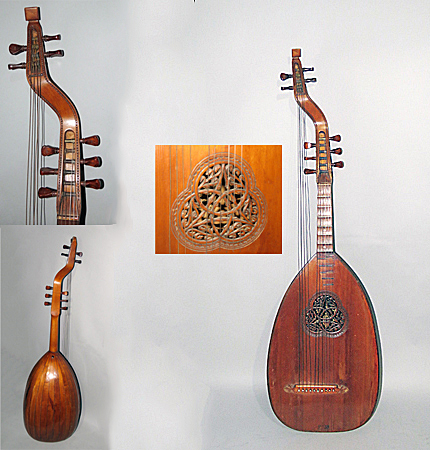
Owner: HWMC
Catalog#: CL-CHHP-05
Lutes - Guitar
W. Ritmüller & Sohn 'Theorbo'
Gottingen, Lower Saxony, Germany
W. Rietmuller & Sohn Baroque Style
Sycamore and plum wood, metal
ca. 1921
Height: 47 in
Strings – Lutes – Guitars
Label inside: W. Ritmüller & Sohn
Inspired by the demand for an extended bass range for use in operas, oratorios, and cantatas, German lute makers working in Italy around 1590 started extending the bass range of the lute by having longer and deeper sounding open (i.e., unfretted) bass strings. These bass strings, called diapasons or bourdons, were carried on a separate peg box. The name, theorbo is given to several long-necked lutes with second peg-boxes, such as the Italian chitarrone and tiorba, or the French angelique or angelica.
This German two-headed theorbo lute has six single strings (fretted) on the lower head, four strings on the upper with its swan neck, a double peg box and a pear-shaped body.
In the late 18th century, Andreas Georg Ritmüller and his son, Gottlieb Wilhelm Ritmüller (1772-1829), began production of lutes, guitars, and harps in Göttingen, Germany. In 1795, the production of pianos began in their workshop, and after the father’s death in c. 1800, the company was officially named “G. W. Ritmüller.” The two sons of Gottlieb Wilhelm Ritmüller, Johann Wilhelm and Johann Martin, joined the company. Gottlieb Wilhelm Ritmüller died in 1829, and the company was renamed “W. Ritmüller & Sohn,” as seen on the label of this theorbo.
Resource: https://en.wikipedia.org/wiki/W._Ritm%C3%BCller_%26_Sohn
